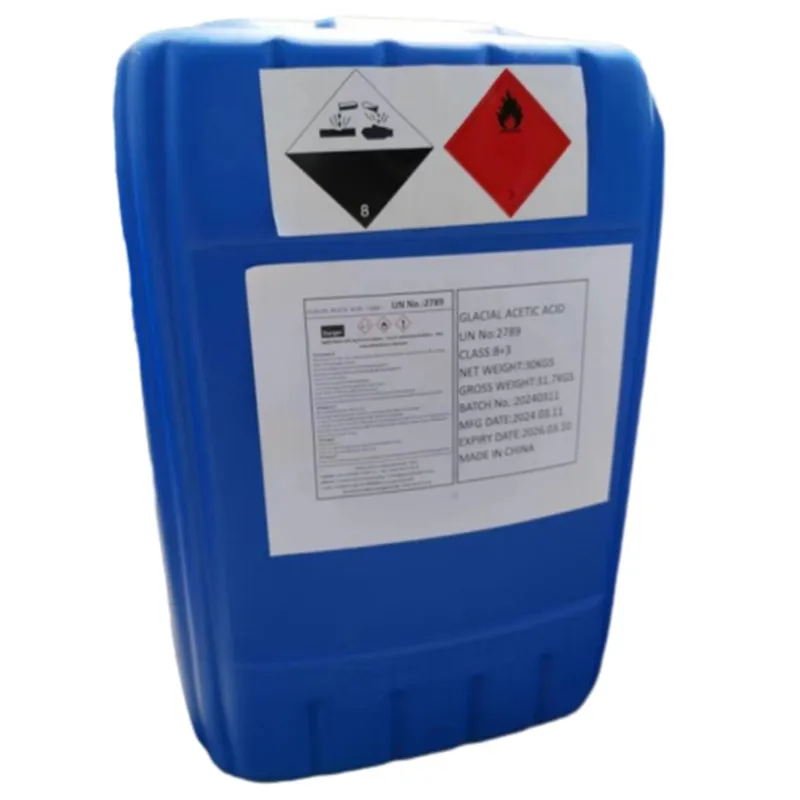
glacial aceticacid
Understanding Glacial Acetic Acid Properties, Uses, and Safety
Glacial acetic acid, chemically represented as CH₃COOH, is a colorless liquid that is a key industrial chemical and a vital component in various chemical processes. Distinguished from its aqueous counterpart, which is commonly referred to as acetic acid, glacial acetic acid is essentially pure acetic acid without any water, boasting a high concentration that can exceed 99%. In this article, we will explore its properties, applications, and safety considerations.
Properties of Glacial Acetic Acid
Glacial acetic acid has several defining characteristics. With a boiling point of around 118 degrees Celsius and a freezing point of 16 degrees Celsius, it is a liquid at room temperature but can solidify into ice-like crystals at low temperatures. It possesses a distinctive pungent smell that is often associated with vinegar, as vinegar is a dilute solution of acetic acid. The compound is highly hygroscopic, meaning it readily absorbs moisture from the air, which is a factor to consider when storing it.
In terms of its chemical behavior, glacial acetic acid can act as both a weak acid and a polar solvent. It is capable of forming hydrogen bonds, making it an effective solvent for a variety of organic compounds. Its functional properties allow it to participate in numerous chemical reactions, making it a versatile building block in organic synthesis.
Applications of Glacial Acetic Acid
The applications of glacial acetic acid are vast and varied. One of its primary uses is in the production of synthetic fibers, particularly acetate fibers used in textiles. It is a key ingredient in manufacturing cellulose acetate, a widely used film base in photography and a component of various coatings.
glacial aceticacid

In the chemical industry, glacial acetic acid serves as a precursor to the production of several key chemicals. It is used to produce acetic anhydride, which is important in the manufacture of chemical intermediates and is also utilized in the production of pharmaceuticals. Furthermore, it is used to create various esters that are important in flavoring agents and fragrances.
Glacial acetic acid is also widely applied in the food industry as a preservative and flavoring agent. It is recognized as a safe food additive and can be found in a variety of condiments, including pickles and sauces. Its acidity helps inhibit the growth of bacteria and molds, thereby extending the shelf life of food products.
Safety Considerations
Despite its many beneficial uses, glacial acetic acid poses certain risks and must be handled with care. It is corrosive and can cause severe burns upon contact with skin or eyes. Inhalation of its vapors can irritate the respiratory tract and lead to headaches, dizziness, or nausea. Therefore, it is essential to work with it in a well-ventilated area, utilizing appropriate personal protective equipment such as gloves, goggles, and face shields.
Proper storage of glacial acetic acid is also crucial. It should be kept in tightly sealed containers made of compatible materials, such as glass or certain types of plastic, in a cool and dry place away from heat sources or incompatible substances. Additionally, it is imperative to have appropriate spill containment measures in place, as any accidental release could pose significant hazards to health and the environment.
Conclusion
In summary, glacial acetic acid is a critical chemical with diverse applications across many industries, from textiles to food preservation. Understanding its properties and how to handle it safely is essential for anyone working with this potent substance. As industries continue to expand and evolve, glacial acetic acid will remain an important component in the chemical landscape, underscoring the need for responsible use and safety precautions.
-
Pure Sodium Dichloroisocyanurate Dihydrate | Powerful DisinfectantNewsAug.29,2025
-
Industrial Chemicals: Quality & Purity for Every IndustryNewsAug.28,2025
-
Nitrile Rubber Honoring Strict Production StandardsNewsAug.22,2025
-
Aspartame Ingredients Honoring Food Safety ValuesNewsAug.22,2025
-
Fertilizer for Balanced Plant NutritionNewsAug.22,2025
-
Cyanide Gold Processing with High Purity AdditivesNewsAug.22,2025
-
Formic Acid in Textile Dyeing ApplicationsNewsAug.22,2025
Hebei Tenger Chemical Technology Co., Ltd. focuses on the chemical industry and is committed to the export service of chemical raw materials.
-

view more DiethanolisopropanolamineIn the ever-growing field of chemical solutions, diethanolisopropanolamine (DEIPA) stands out as a versatile and important compound. Due to its unique chemical structure and properties, DEIPA is of interest to various industries including construction, personal care, and agriculture. -

view more TriisopropanolamineTriisopropanolamine (TIPA) alkanol amine substance, is a kind of alcohol amine compound with amino and alcohol hydroxyl, and because of its molecules contains both amino and hydroxyl. -

view more Tetramethyl Thiuram DisulfideTetramethyl thiuram disulfide, also known as TMTD, is a white to light-yellow powder with a distinct sulfur-like odor. It is soluble in organic solvents such as benzene, acetone, and ethyl acetate, making it highly versatile for use in different formulations. TMTD is known for its excellent vulcanization acceleration properties, which makes it a key ingredient in the production of rubber products. Additionally, it acts as an effective fungicide and bactericide, making it valuable in agricultural applications. Its high purity and stability ensure consistent performance, making it a preferred choice for manufacturers across various industries.





